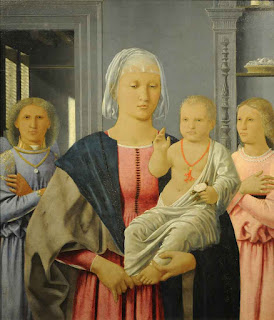New York Review of Books
March 20, 2014
American, or at least New York, lovers of the work of Piero della Francesca—love seems to be a better word than admiration to describe how people feel about this artist—have been given a rare two-part opportunity over the past year. Last winter and spring the Frick Collection brought together a small number of works by the fifteenth-century Italian painter, most coming from American museums. They were principally portraits of saints from an altarpiece, along with Virgin and Child Enthroned with Four Angels, a strong (if not incandescent) picture from the Clark Art Institute, in Williamstown, Massachusetts. It is the one “American” Piero that gives a clear taste of an aspect of his art that made him a particularly exciting figure for painters and writers in the early twentieth century—when he crowds together a number of figures in a tight space, making them feel full-bodied yet flat, like overlapping cards you hold in your hand in a game.
Now the Metropolitan Museum, in “Piero della Francesca: Personal Encounters,” has assembled a few pictures that fortuitously complement the Frick show, which emphasized the grave and hieratic side of the painter’s art. Organized by Keith Christiansen, a curator at the Met, the current exhibition is the first ever about Piero’s devotional works. They are small-size paintings created for bedrooms or set-apart areas in the home. In spirit they take us to much the same austere and bare-bones realm as his more public pictures. Yet they present more directly and pleasurably the qualities that make Piero such a special figure, even by the heady standards of the fifteenth century, when so many Italian and Flemish artists, newly working with oil paint, were finding one personal way after another to portray the actual, corporeal world they lived in.
Piero was an obsessively methodical artist. He spent his last decades—he died in 1492, probably around age eighty—not painting but, rather, writing treatises on geometry and perspective. His goal was to bring the laws of perspective and measurement to bear on his scenes, and in the process he turned figures and aspects of buildings, even items of clothing, into so many precisely self-contained shapes. Yet his militant orderliness was of a piece with an extraordinary feeling for character and emotion. In their bearing and marvelous faces, the people in his pictures are shy, and also aloof, in a way few artists have matched. His figures can be strangely contemporary in their sexiness, and there is nothing dated about the way they encounter and judge one another, or appraise us.
More
